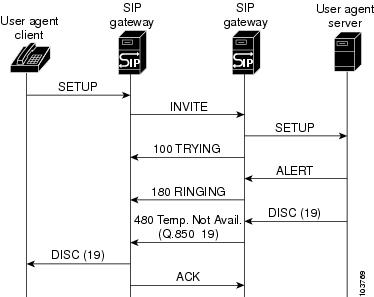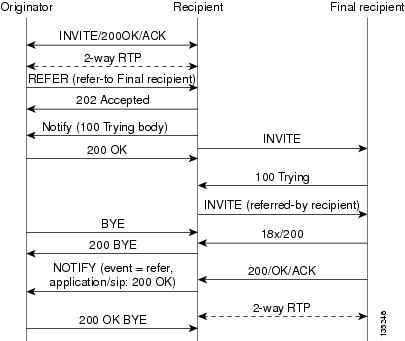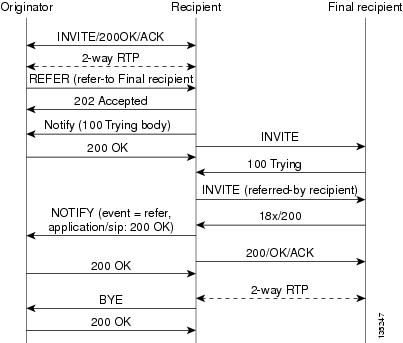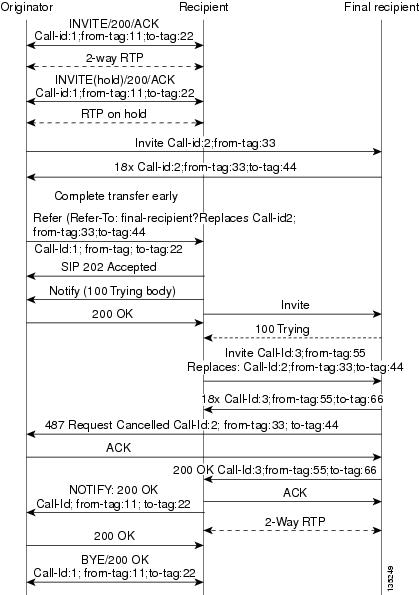| Step 1 |
show
call
active
voice
Use this command to display call information for voice calls in progress.
| Note
|
For sample output, see "Monitor the Hostname in Locally Generated SIP Headers".
|
|
| Step 2 |
show
call
application
sessions
Use this command to view whether the application is running.
Router# show call application sessions
TCL Sessions
There are 1 active TCL sessions
SID Name Called Calling App Name Legs
1 50276 50280 testapp31 4
VXML Sessions
No running VXML sessions
|
| Step 3 |
show
call
history
Use this command, optionally with the
voice keyword, to display the call history table for voice calls.
Router# show call history
DisconnectCause=10
DisconnectText=normal call clearing
.
.
.
| Note
|
For more sample output, see "Monitor the Hostname in Locally Generated SIP Headers".
|
|
| Step 4 |
show
logging
Use this command to display the state of logging (syslog).
The following partial sample output shows that the outgoing gateway is receiving a 180 message with SDP and is configured
to ignore the SDP.
Router# show logging
Log Buffer (600000 bytes):
00:12:19:%SYS-5-CONFIG_I:Configured from console by console
00:12:19:%SYS-5-CONFIG_I:Configured from console by console
00:12:20:0x639F6EEC :State change from (STATE_NONE, SUBSTATE_NONE) to
(STATE_IDLE, SUBSTATE_NONE)
00:12:20:****Adding to UAC table
00:12:20:adding call id 2 to table
00:12:20: Queued event from SIP SPI :SIPSPI_EV_CC_CALL_SETUP
00:12:20:CCSIP-SPI-CONTROL: act_idle_call_setup
00:12:20: act_idle_call_setup:Not using Voice Class Codec
00:12:20:act_idle_call_setup:preferred_codec set[0] type :g711ulaw
bytes:160
00:12:20:sipSPICopyPeerDataToCCB:From CLI:Modem NSE payload = 100,
Passthrough = 0,Modem relay = 0, Gw-Xid = 1
SPRT latency 200, SPRT Retries = 12, Dict Size = 1024
String Len = 32, Compress dir = 3
00:12:20:sipSPICanSetFallbackFlag - Local Fallback is not active
00:12:20:****Deleting from UAC table
00:12:20:****Adding to UAC table
00:12:20: Queued event from SIP SPI :SIPSPI_EV_CREATE_CONNECTION
00:12:20:0x639F6EEC :State change from (STATE_IDLE, SUBSTATE_NONE) to
(STATE_IDLE, SUBSTATE_CONNECTING)
00:12:20:0x639F6EEC :State change from (STATE_IDLE,
SUBSTATE_CONNECTING) to (STATE_IDLE, SUBSTATE_CONNECTING)
00:12:20:sipSPIUsetBillingProfile:sipCallId for billing records =
41585FCE-14F011CC-8005AF80-D4AA3153@10.1.1.42
00:12:20:CCSIP-SPI-CONTROL: act_idle_connection_created
00:12:20:CCSIP-SPI-CONTROL: act_idle_connection_created:Connid(1)
created to 10.1.1.15:5060, local_port 57838
00:12:20:CCSIP-SPI-CONTROL: sipSPIOutgoingCallSDP
00:12:20:sipSPISetMediaSrcAddr: media src addr for stream 1 = 10.1.1.42
00:12:20:sipSPIReserveRtpPort:reserved port 18978 for stream 1
00:12:20: convert_codec_bytes_to_ptime:Values :Codec:g711ulaw
codecbytes :160, ptime:20
00:12:20:sip_generate_sdp_xcaps_list:Modem Relay disabled. X-cap not needed
00:12:20:Received Octet3A=0x00 -> Setting ;screen=no ;privacy=off
00:12:20:sipSPIAddLocalContact
00:12:20: Queued event from SIP SPI :SIPSPI_EV_SEND_MESSAGE
00:12:20:sip_stats_method
00:12:20:sipSPIProcessRtpSessions
00:12:20:sipSPIAddStream:Adding stream 1 (callid 2) to the VOIP RTP library
00:12:20:sipSPISetMediaSrcAddr: media src addr for stream 1 = 10.1.1.42
00:12:20:sipSPIUpdateRtcpSession:for m-line 1
00:12:20:sipSPIUpdateRtcpSession:rtcp_session info
laddr = 10.1.1.42, lport = 18978, raddr = 0.0.0.0,
rport=0, do_rtcp=FALSE
src_callid = 2, dest_callid = -1
00:12:20:sipSPIUpdateRtcpSession:No rtp session, creating a new one
00:12:20:sipSPIAddStream:In State Idle
00:12:20:act_idle_connection_created:Transaction active. Facilities will be queued.
00:12:20:0x639F6EEC :State change from (STATE_IDLE,
SUBSTATE_CONNECTING) to (STATE_SENT_INVITE, SUBSTATE_NONE)
00:12:20:Sent:
INVITE sip:222@10.1.1.15:5060 SIP/2.0
Via:SIP/2.0/UDP 10.1.1.42:5060
From:"111" <sip:111@10.1.1.42>;tag=B4DC4-9E1
To:<sip:222@10.1.1.15>
Date:Mon, 01 Mar 1993 00:12:20 GMT
Call-ID:41585FCE-14F011CC-8005AF80-D4AA3153@10.1.1.42
Supported:timer
Min-SE: 1800
Cisco-Guid:1096070726-351277516-2147659648-3567923539
User-Agent:Cisco-SIPGateway/IOS-12.x
Allow:INVITE, OPTIONS, BYE, CANCEL, ACK, PRACK, COMET, Refer , SUBSCRIBE,
NOTIFY, INFO
CSeq:101 INVITE
Max-Forwards:6
Remote-Party-ID:<sip:111@10.1.1.42>;party=calling;screen=no;privacy=off
Timestamp:730944740
Contact:<sip:111@10.1.1.42:5060>
Expires:180
Allow-Events:telephone-event
Content-Type:application/sdp
Content-Length:230
v=0
o=CiscoSystemsSIP-GW-UserAgent 4629 354 IN IP4 10.1.1.42
s=SIP Call
c=IN IP4 10.1.1.42
t=0 0
m=audio 18978 RTP/AVP 0 100
c=IN IP4 10.1.1.42
a=rtpmap:0 PCMU/8000
a=rtpmap:100 X-NSE/8000
a=fmtp:100 192-194
a=ptime:20
00:12:21:Received:
SIP/2.0 100 Trying
Via:SIP/2.0/UDP 10.1.1.42:5060
From:"111" <sip:111@10.1.1.42>;tag=B4DC4-9E1
To:<sip:222@10.1.1.15>;tag=442AC-22
Date:Wed, 16 Feb 2000 18:19:56 GMT
Call-ID:41585FCE-14F011CC-8005AF80-D4AA3153@10.1.1.42
Timestamp:730944740
Server:Cisco-SIPGateway/IOS-12.x
CSeq:101 INVITE
Allow-Events:telephone-event
Content-Length:0
00:12:21:HandleUdpSocketReads :Msg enqueued for SPI with IPaddr:
10.1.1.15:5060
00:12:21:CCSIP-SPI-CONTROL: act_sentinvite_new_message
00:12:21:CCSIP-SPI-CONTROL: sipSPICheckResponse
00:12:21:sip_stats_status_code
00:12:21: Roundtrip delay 420 milliseconds for method INVITE
00:12:21:0x639F6EEC :State change from (STATE_SENT_INVITE,
SUBSTATE_NONE) to (STATE_RECD_PROCEEDING, SUBSTATE_PROCEEDING_PROCEEDING)
00:12:21:Received:
SIP/2.0 180 Ringing
Via:SIP/2.0/UDP 10.1.1.42:5060
From:"111" <sip:111@10.1.1.42>;tag=B4DC4-9E1
To:<sip:222@10.1.1.15>;tag=442AC-22
Date:Wed, 16 Feb 2000 18:19:56 GMT
Call-ID:41585FCE-14F011CC-8005AF80-D4AA3153@10.1.1.42
Timestamp:730944740
Server:Cisco-SIPGateway/IOS-12.x
CSeq:101 INVITE
Allow-Events:telephone-event
Contact:<sip:222@192.0.2.59:5060>
Record-Route:<sip:222@10.1.1.15:5060;maddr=10.1.1.15>
Content-Length:230
Content-Type:application/sdp
v=0
o=CiscoSystemsSIP-GW-UserAgent 4629 354 IN IP4 10.1.1.42
s=SIP Call
c=IN IP4 10.1.1.42
t=0 0
m=audio 18978 RTP/AVP 0 100
c=IN IP4 10.1.1.42
a=rtpmap:0 PCMU/8000
a=rtpmap:100 X-NSE/8000
a=fmtp:100 192-194
a=ptime:20
00:12:21:HandleUdpSocketReads :Msg enqueued for SPI with IPaddr:
10.1.1.15:5060
00:12:21:CCSIP-SPI-CONTROL: act_recdproc_new_message
00:12:21:CCSIP-SPI-CONTROL: act_recdproc_new_message_response
00:12:21:CCSIP-SPI-CONTROL: sipSPICheckResponse
00:12:21:sip_stats_status_code
00:12:21: Roundtrip delay 496 milliseconds for method INVITE
00:12:21:CCSIP-SPI-CONTROL: act_recdproc_new_message_response :Early
media disabled for 180:Ignoring SDP if present
00:12:21:HandleSIP1xxRinging:SDP in 180 will be ignored if present: No
early media cut through
00:12:21:HandleSIP1xxRinging:SDP Body either absent or ignored in 180
RINGING:- would wait for 200 OK to do negotiation.
00:12:21:HandleSIP1xxRinging:MediaNegotiation expected in 200 OK
00:12:21:sipSPIGetGtdBody:No valid GTD body found.
00:12:21:sipSPICreateRawMsg:No GTD passed.
00:12:21:0x639F6EEC :State change from (STATE_RECD_PROCEEDING,
SUBSTATE_PROCEEDING_PROCEEDING) to (STATE_RECD_PROCEEDING,
SUBSTATE_PROCEEDING_ALERTING)
00:12:21:HandleSIP1xxRinging:Transaction Complete. Lock on Facilities
released.
00:12:22:Received:
SIP/2.0 200 OK
Via:SIP/2.0/UDP 10.1.1.42:5060
From:"111" <sip:111@10.1.1.42>;tag=B4DC4-9E1
To:<sip:222@10.1.1.15>;tag=442AC-22
Date:Wed, 16 Feb 2000 18:19:56 GMT
Call-ID:41585FCE-14F011CC-8005AF80-D4AA3153@10.1.1.42
Timestamp:730944740
Server:Cisco-SIPGateway/IOS-12.x
CSeq:101 INVITE
Allow:INVITE, OPTIONS, BYE, CANCEL, ACK, PRACK, COMET, Refer , SUBSCRIBE,
NOTIFY, INFO
Allow-Events:telephone-event
Contact:<sip:222@10.1.1.59:5060>
Record-Route:<sip:222@10.1.1.15:5060;maddr=10.1.1.15>
Content-Type:application/sdp
Content-Length:231
v=0
o=CiscoSystemsSIP-GW-UserAgent 9600 4816 IN IP4 10.1.1.59
s=SIP Call
c=IN IP4 10.1.1.59
t=0 0
m=audio 19174 RTP/AVP 0 100
c=IN IP4 10.1.1.59
a=rtpmap:0 PCMU/8000
a=rtpmap:100 X-NSE/8000
a=fmtp:100 192-194
a=ptime:20
|
| Step 5 |
show
running-config
Use this command to display the contents of the currently running configuration file or the configuration for a specific
interface. Use it to display the current configuration and to verify header passing and subscription configuration.
| Note
|
If early media (the default setting) is enabled, this command does not show any information related to the feature.
|
The following sample output shows that the disable-early-media 180 command was used.
Router# show running-config
.
.
.
dial-peer voice 223 pots
application session
destination-pattern 223
port 1/0/0
!
gateway
!
sip-ua
disable-early-media 180
|
| Step 6 |
show
sip
min-se
Use this command to show the current value of a minimum-session-expiration header for calls that use SIP.
Router# show sip min-se
SIP UA MIN-SE Value (seconds)
Min-SE: 90
|
| Step 7 |
show
sip-ua
map
pstn-sip
Use this command to display the mapping table of PSTN cause codes and their corresponding SIP error status codes or the mapping
table of PSTN-to-SIP codes.
Router# show sip-ua map pstn-sip
PSTN-Cause Configured Default
SIP-Status SIP-Status
1 404 404
2 404 404
3 404 404
4 500 500
.
.
.
110 500 500
111 400 400
126 500 500
127 500 500
|
| Step 8 |
show
sip-ua
map
sip-pstn
Use this command to display the mapping table of PSTN cause codes and their corresponding SIP error status codes or the mapping
table of SIP-to-PSTN codes.
Router# show sip-ua map sip-pstn
SIP-Status Configured Default
PSTN-Cause PSTN-Cause
400 127 127
401 57 57
402 21 21
403 57 57
.
.
.
600 17 17
603 21 21
604 1 1
606 58 58
|
| Step 9 |
show
sip-ua
statistics
Use this command to display response, traffic, and retry SIP statistics, including the Bad Request counter. Use it to verify
configuration of the SIP INVITE Request with Malformed Via Header feature, which increments a counter (shown as
Client Error: Bad Request ) when a malformed Via header is received.
| Note
|
To reset counters after you view statistics, use the
clear
sip-ua
statistics command.
|
The following sample output shows response, traffic, and retry SIP statistics, including the Bad Request counter. Use it
to verify configuration of the SIP INVITE Request with Malformed Via Header feature, which increments a counter (shown as
Client Error: Bad Request ) when a malformed Via header is received.
Router# show sip-ua statistics
SIP Response Statistics (Inbound/Outbound
)
Informational:
Trying 0/0, Ringing 0/0,
Forwarded 0/0, Queued 0/0,
SessionProgress 0/0
Success:
OkInvite 0/0, OkBye 0/0,
OkCancel 0/0, OkOptions 0/0,
OkPrack 0/0, OkPreconditionMet 0/0
Redirection (Inbound only):
MultipleChoice 0, MovedPermanently 0,
MovedTemporarily 0, SeeOther 0,
UseProxy 0, AlternateService 0
Client Error:
BadRequest
0/0
, Unauthorized 0/0,
PaymentRequired 0/0, Forbidden 0/0,
NotFound 0/0, MethodNotAllowed 0/0,
NotAcceptable 0/0, ProxyAuthReqd 0/0,
ReqTimeout 0/0, Conflict 0/0, Gone 0/0,
LengthRequired 0/0, ReqEntityTooLarge 0/0,
ReqURITooLarge 0/0, UnsupportedMediaType 0/0,
BadExtension 0/0, TempNotAvailable 0/0,
CallLegNonExistent 0/0, LoopDetected 0/0,
TooManyHops 0/0, AddrIncomplete 0/0,
Ambiguous 0/0, BusyHere 0/0,
RequestCancel 0/0, NotAcceptableMedia 0/0
Server Error:
InternalError 0/0, NotImplemented 0/0,
BadGateway 0/0, ServiceUnavail 0/0,
GatewayTimeout 0/0, BadSipVer 0/0,
PreCondFailure 0/0
Global Failure:
BusyEverywhere 0/0, Decline 0/0,
NotExistAnywhere 0/0, NotAcceptable 0/0
SIP Total Traffic Statistics (Inbound/Outbound)
Invite 0/0, Ack 0/0, Bye 0/0,
Cancel 0/0, Options 0/0,
Prack 0/0, Comet 0/0
Retry Statistics
Invite 0, Bye 0, Cancel 0, Response 0,
Prack 0, Comet 0, Reliable1xx 0
|
| Step 10 |
show
sip-ua
status
Use this command to display status for the SIP user agent.
The following sample output shows status for the SIP user agent after the
disable-early-media
180 command was used.
Router# show sip-ua status
SIP User Agent Status
SIP User Agent for UDP :ENABLED
SIP User Agent for TCP :ENABLED
SIP User Agent bind status(signaling):ENABLED 10.0.0.0
SIP User Agent bind status(media):ENABLED 0.0.0.0
SIP early-media for 180 responses with SDP:DISABLED
SIP max-forwards :6
SIP DNS SRV version:2 (rfc 2782)
NAT Settings for the SIP-UA
Role in SDP:NONE
Check media source packets:DISABLED
Redirection (3xx) message handling:ENABLED
SDP application configuration:
Version line (v=) required
Owner line (o=) required
Timespec line (t=) required
Media supported:audio image
Network types supported:IN
Address types supported:IP4
Transport types supported:RTP/AVP udptl
|
| Step 11 |
show
sip-ua
timers
Use this command to display all SIP UA information.
Router# show sip-ua timers
SIP UA Timer Values (millisecs)
trying 500, expires 150000, connect 500, disconnect 500
comet 500, prack 500, rel1xx 500, notify 500, refer 500,
hold 2880 minutes, buffer-invite 500
|
| Step 12 |
show
subscription
{asnl
session {active |
history [errors |
session-id
session-id |
url ] |
statistics } |
sip } [summary ]
Use this command to display information about Application SUBSCRIBE/NOTIFY Layer (ASNL)-based and non-ASNL-based SIP subscriptions.
Router# show subscription asnl session history
ASNL Subscription History Records Details:
==========================================
Total history records = 1
Total error count = 0
Total subscription requests sent = 1
Total subscription requests received = 0
Total notification requests sent = 0
Total notification requests received = 3
URL: sip:user@10.7.104.88
Event Name : stress
Session ID : 8
Expiration Time : 50 seconds
Subscription Duration : 10 seconds
Protocol : ASNL_PROTO_SIP
Remote IP address : 10.7.104.88
Port : 5060
Call ID : 5
Total Subscriptions Sent : 1
Total Subscriptions Received: 0
Total Notifications Sent : 0
Total Notifications Received : 3
Last response code : ASNL_UNSUBSCRIBE_SUCCESS
Last error code : ASNL_NONE
First Subscription Time : 10:55:12 UTC Apr 9 2000
Last Subscription Time : 10:55:12 UTC Apr 9 2000
First Notify Time : 10:55:12 UTC Apr 9 2000
Last Notify Time : 10:55:22 UTC Apr 9 2000
Router# show subscription asnl session history summary
ASNL Subscription History Records Summary:
==========================================
Total history records = 2
Total error count = 0
Total subscription requests sent = 2
Total subscription requests received = 0
Total notification requests sent = 0
Total notification requests received = 6
URL Session ID Call ID
--- ---------- -------
sip:user@10.7.104.88 9 5
sip:user@10.7.104.88 8 5
The following sample output shows the error type ASNL_SUBSCRIBE_FAILED. This error indicates that the subscription request
has failed.
Router# show subscription asnl session history summary
ASNL Subscription History Records Summary:
==========================================
Total history records = 8
Total error count = 6
Total error type (ASNL_SUBSCRIBE_FAILED) = 6
Total subscription requests sent = 8
Total subscription requests received = 0
Total notification requests sent = 0
Total notification requests received = 6
URL Session ID Call ID
--- ---------- -------
sip:user@10.7.104.88 15 N/A
ASNL_SUBSCRIBE_FAILED
sip:user@10.7.104.88 14 N/A
ASNL_SUBSCRIBE_FAILED
sip:user@10.7.104.88 13 N/A
ASNL_SUBSCRIBE_FAILED
sip:user@10.7.104.88 12 N/A
ASNL_SUBSCRIBE_FAILED
sip:user@10.7.104.88 11 N/A
ASNL_SUBSCRIBE_FAILED
sip:user@10.7.104.88 10 N/A
ASNL_SUBSCRIBE_FAILED
sip:user@10.7.104.88 9 5
sip:user@10.7.104.88 8 5
Router# show subscription asnl session history error
ASNL Subscription History Error Statistics:
===========================================
Total history records = 8
Total history records with errors = 6
URL : sip:user@10.7.104.88
Session ID: 15
Call ID : N/A
Event Name: newstress
Error : ASNL_SUBSCRIBE_FAILED
URL : sip:user@10.7.104.88
Session ID: 14
Call ID : N/A
Event Name: newstress
Error : ASNL_SUBSCRIBE_FAILED
URL : sip:user@10.7.104.88
Session ID: 13
Call ID : N/A
Event Name: newstress
Error : ASNL_SUBSCRIBE_FAILED
URL : sip:user@10.7.104.88
Session ID: 12
Call ID : N/A
Event Name: newstress
Error : ASNL_SUBSCRIBE_FAILED
URL : sip:user@10.7.104.88
Session ID: 11
Call ID : N/A
Event Name: newstress
Error : ASNL_SUBSCRIBE_FAILED
URL : sip:user@10.7.104.88
Session ID: 10
Call ID : N/A
Event Name: newstress
Error : ASNL_SUBSCRIBE_FAILED
Router# show subscription asnl session history url
ASNL Subscription History URL Records Details:
==============================================
Total history records = 3
Total history records with errors = 0
Total number of different URLs = 1
Total number of different events = 2
Total subscription requests sent = 3
Total subscription requests received = 0
Total notification requests sent = 0
Total notification requests received = 9
URL: sip:user@10.7.104.88
Event Name: stress1
Session ID: 19 Call ID: N/A
Event Name: stress
Session ID: 18 Call ID: 5
Event Name: newstress
Session ID: 17 Call ID: N/A
Total error count for this URL = 0
Total events subscribed by this URL = 0
Total subscription requests sent for this URL = 3
Total subscription requests received for this URL = 0
Total notification requests sent for this URL = 0
Total notification requests received for this URL = 9
Router# show subscription asnl session history url summary
ASNL Subscription History URL Records Summary:
==============================================
Total history records = 3
Total history records with errors = 0
Total number of different URLs = 1
Total number of different events = 2
Total subscription requests sent = 3
Total subscription requests received = 0
Total notification requests sent = 0
Total notification requests received = 9
Router# show subscription asnl session statistics
ASNL Subscription and Notification Statistics:
==============================================
Total subscription requests sent = 3
|





























 Feedback
Feedback